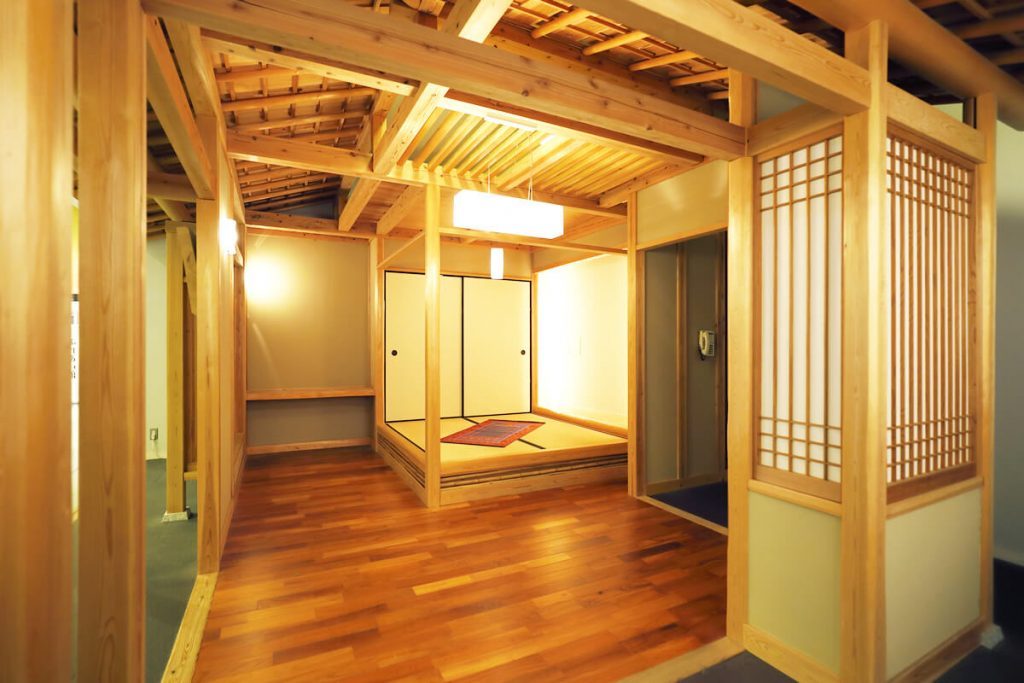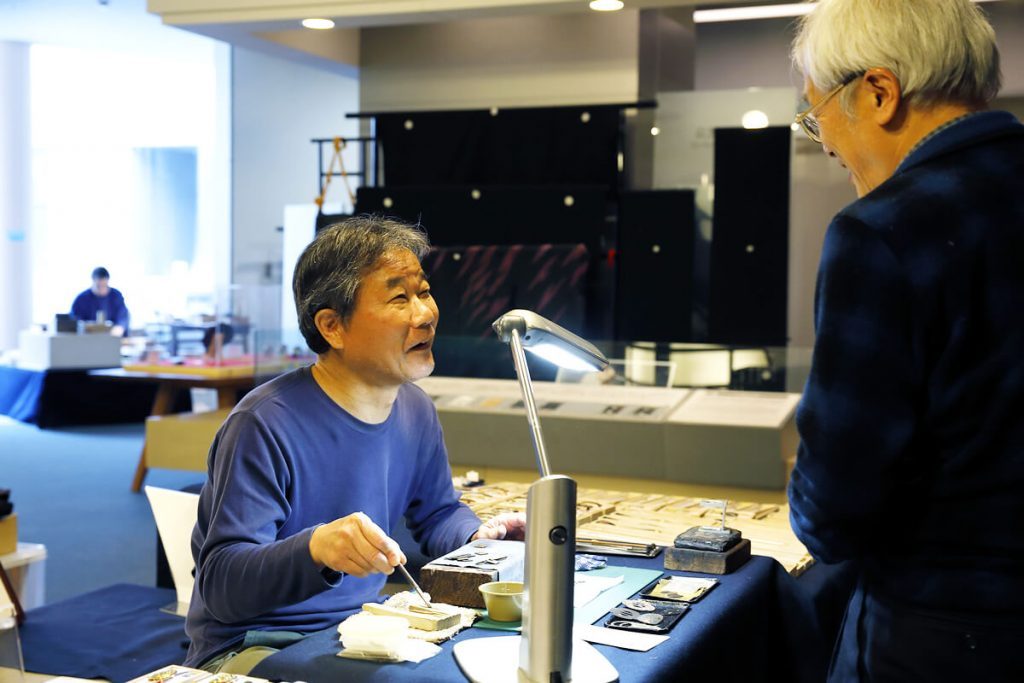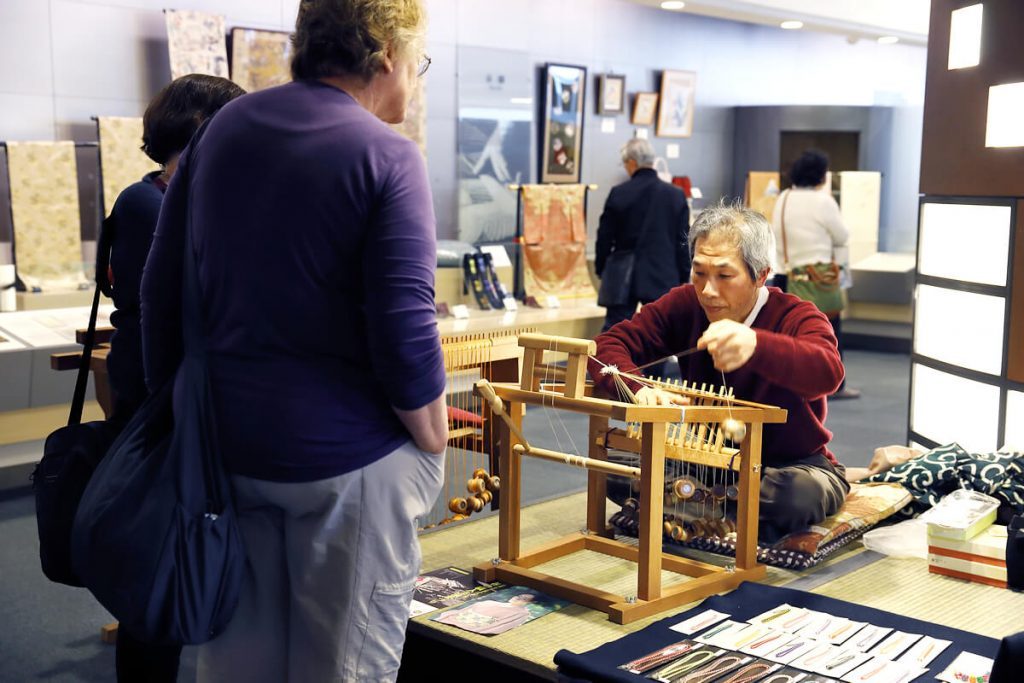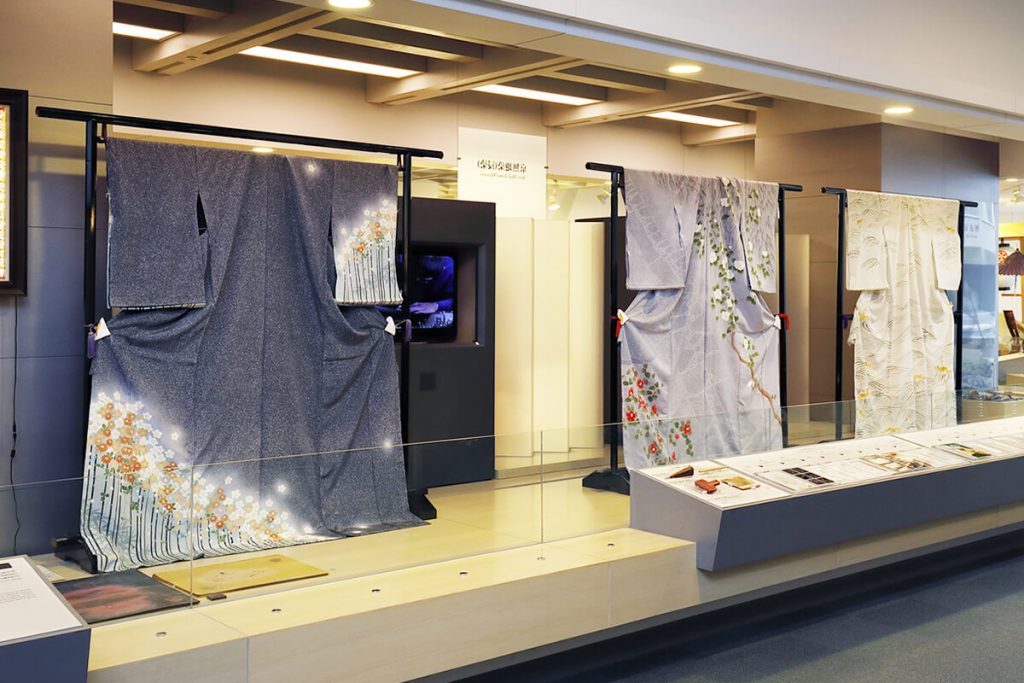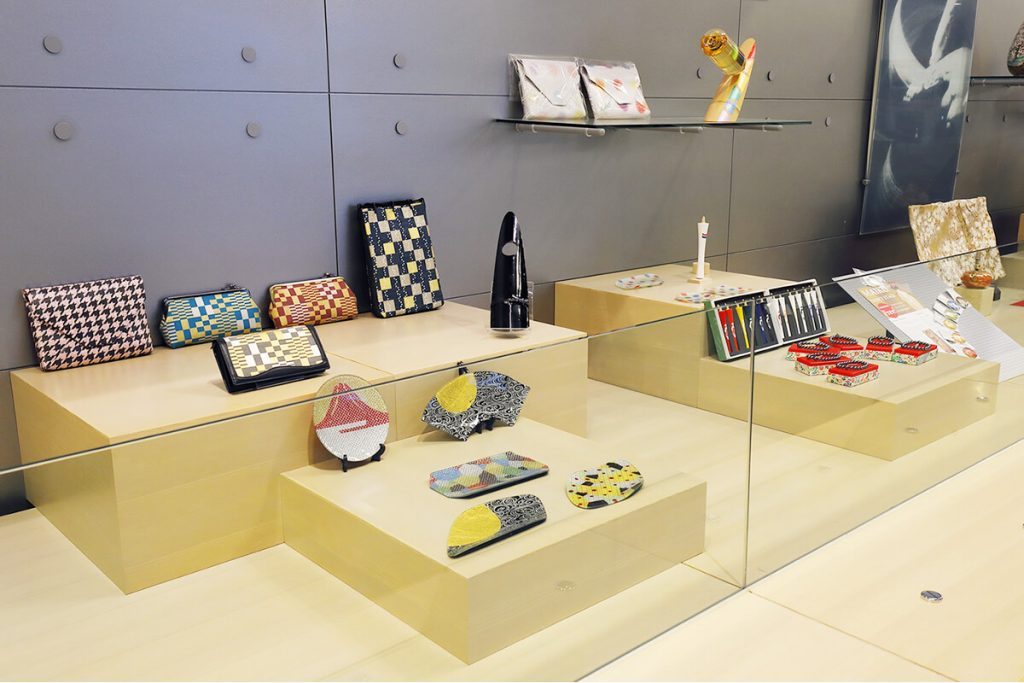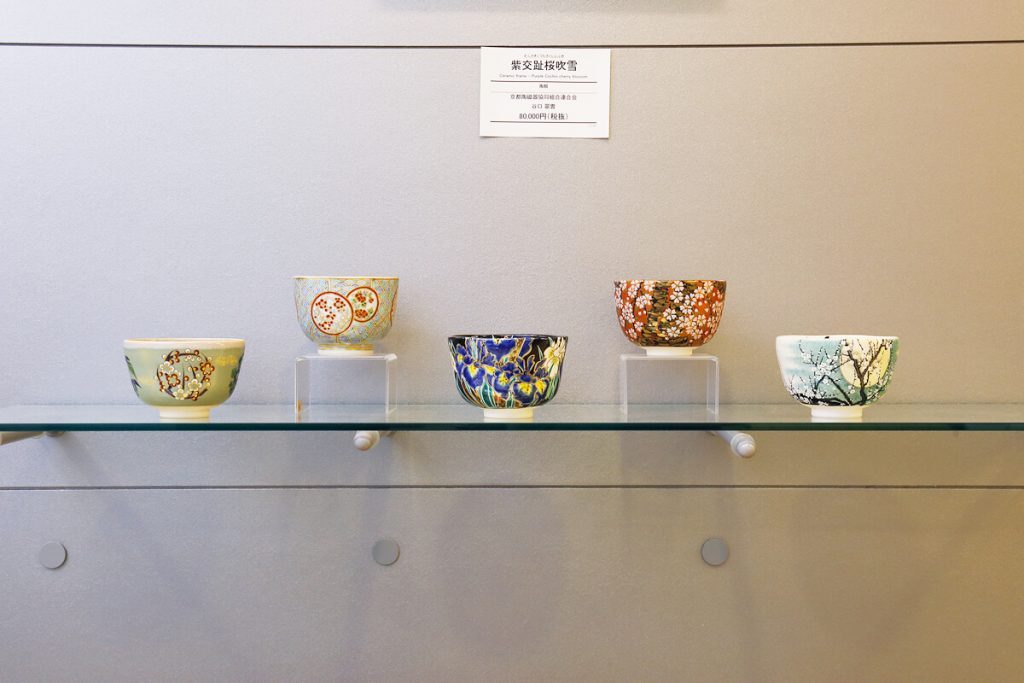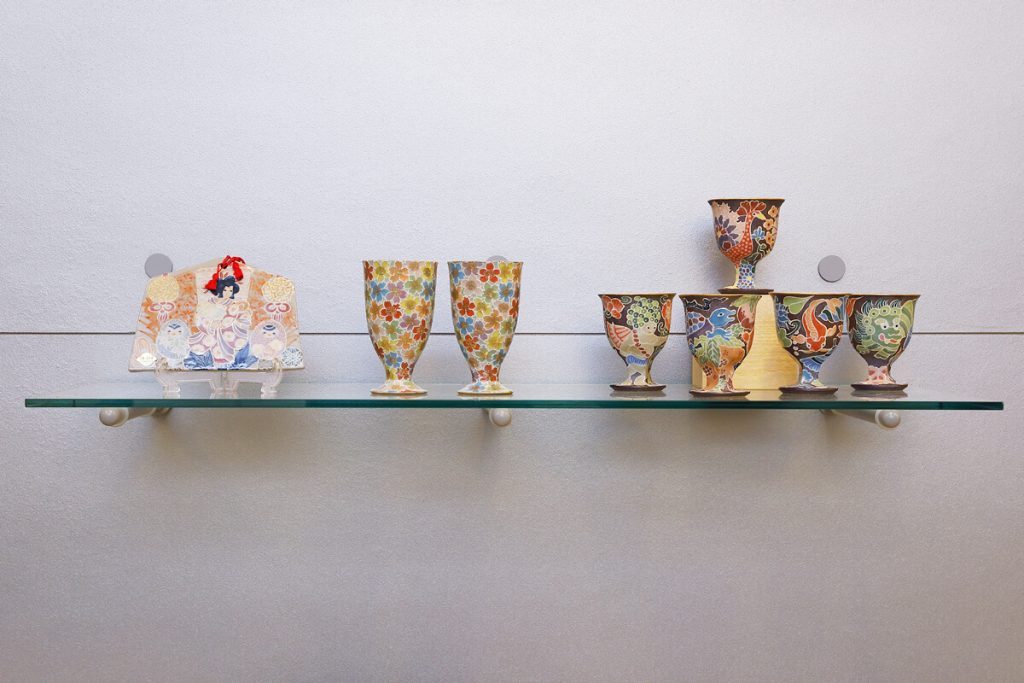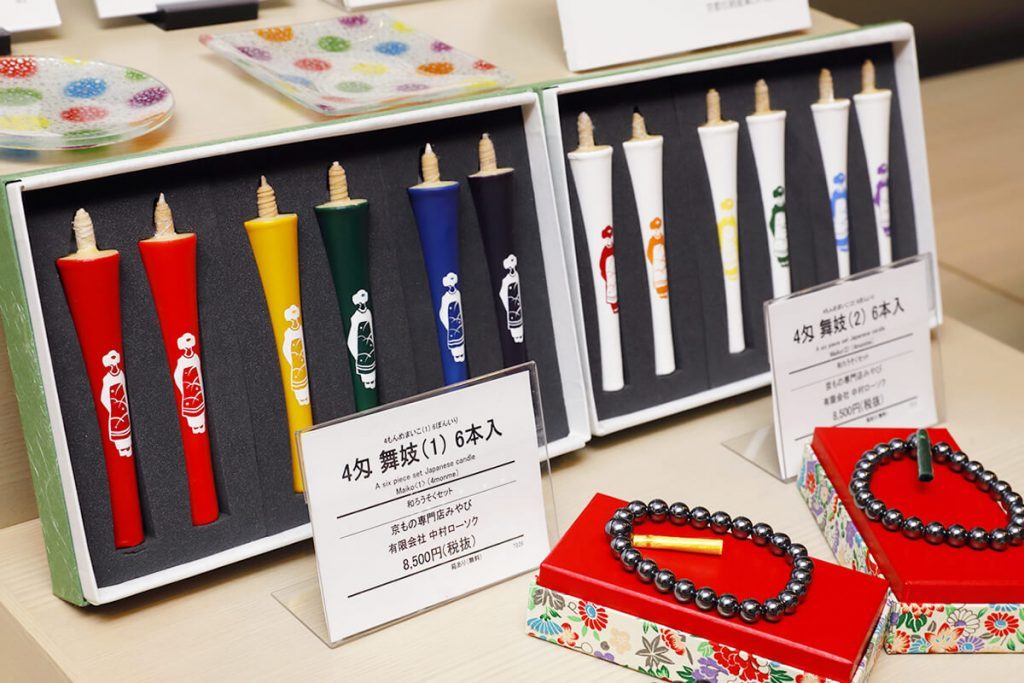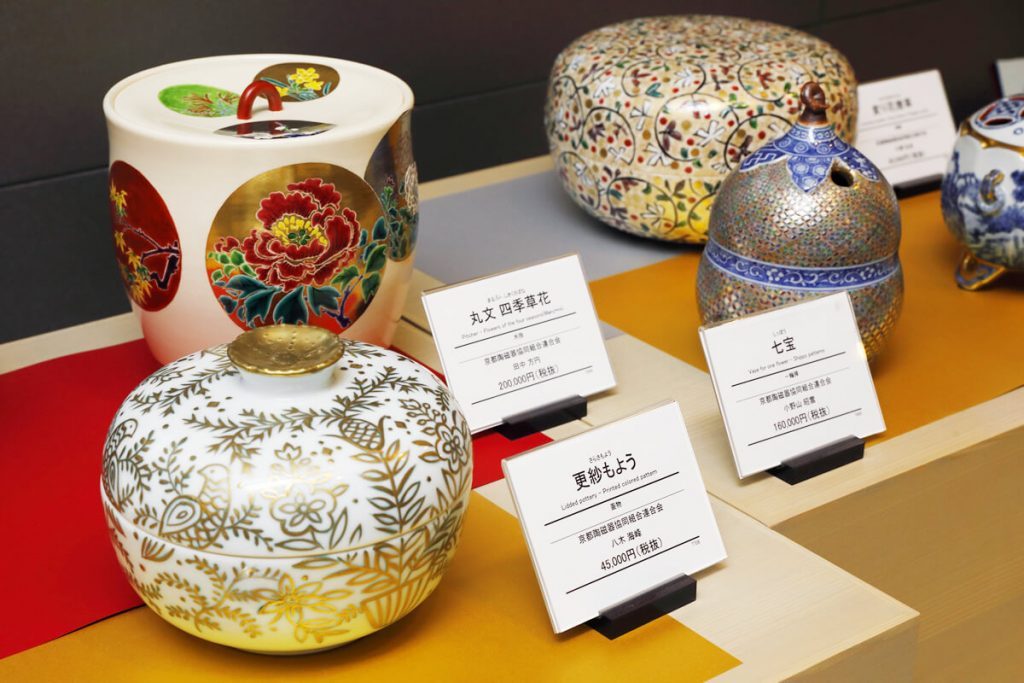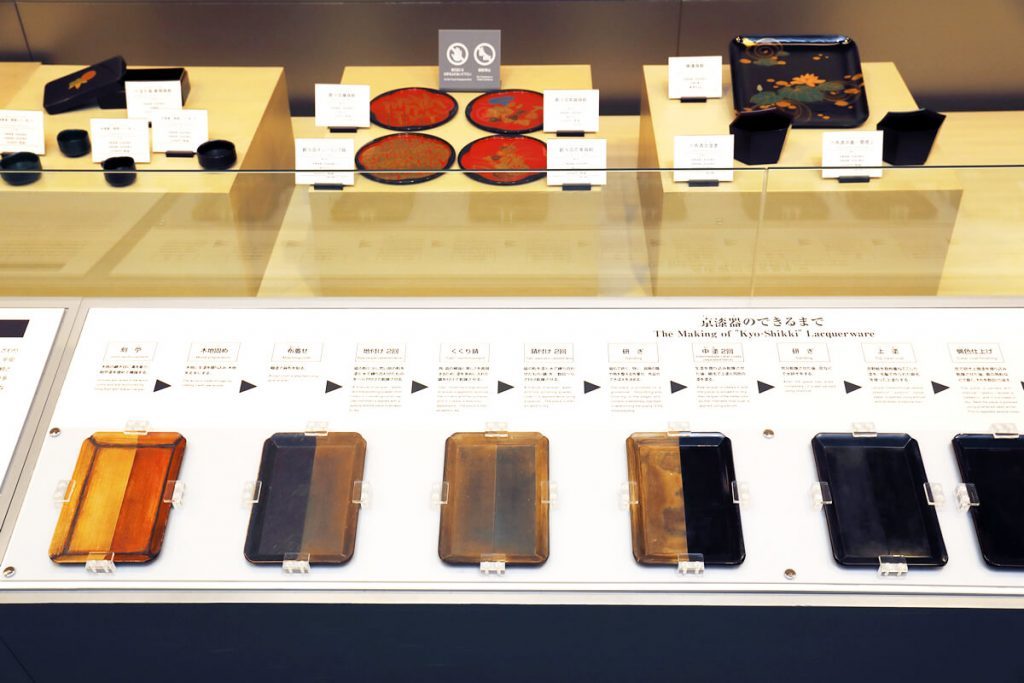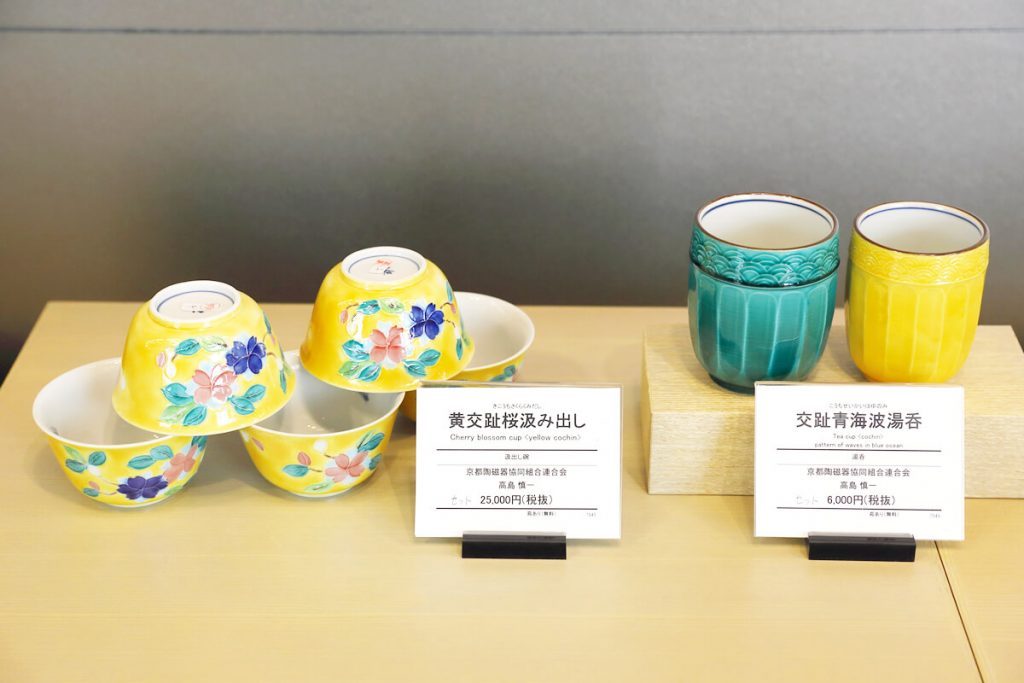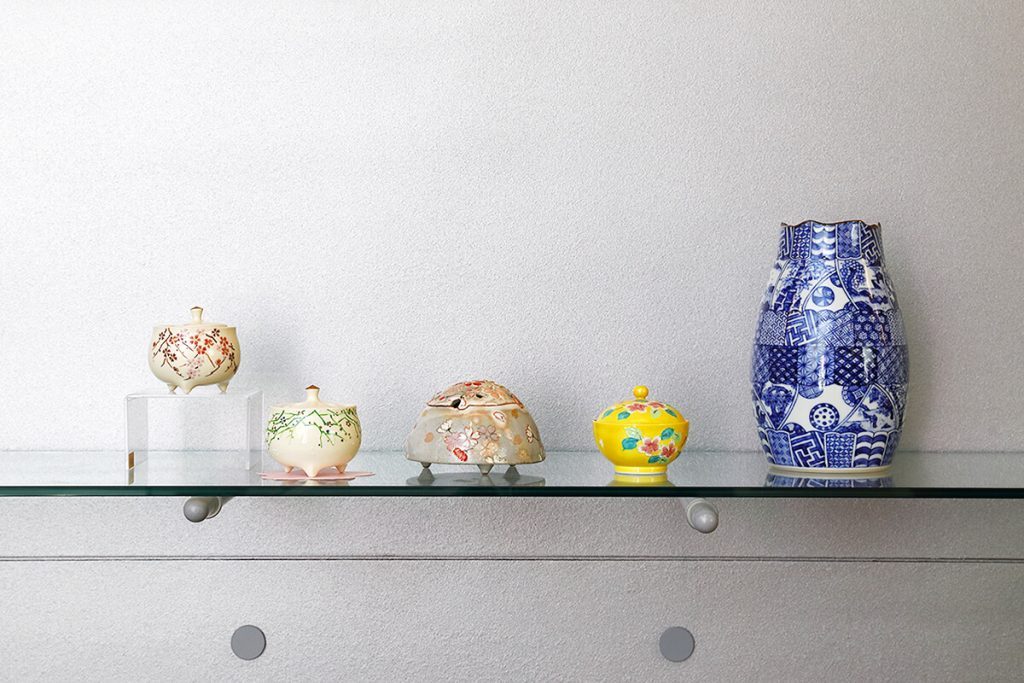VIRTUAL GALLERY
HOME > EXHIBITION > VIRTUAL GALLERY
Google Arts & Culture
Kyoto Museum of Crafts and Design participates in Made in Japan, a project of the online platform Google Arts & Culture developed in collaboration with the Kyoto Women’s University. The project showcases images and videos presenting the history and appeal of exquisite Kyoto crafts. Please enjoy the online world of traditional handicrafts available in Japanese and English.

(discover the collection of FUREAIKAN on Google Arts & Culture)
Videos
Kyoto Museum of Crafts and Design

The museum welcomes you with its machiya-style entrance and inner garden, so characteristic of Kyoto atmosphere.. Enter the world of traditional crafts.
Traditional crafts are the essence of Kyoto history and culture, and FUREAIKAN is the only place where all of them can be discovered at once -- permanent exhibition brings together all the 74 categories of Kyoto traditional industries. Crafts and their techniques are introduced and explained one by one through 500 artifacts, panel displays and videos.. A craft lovers’ paradise!
Craft items with price tag are on sale. Please let us know if something pleases your eye!
Nishijin-ori (Nishijin woven textiles)

Brought to Japan from the continent in the 5th-6th century, the Nishijin weaving industry prospered after establishment of government-operated weaving shops at the same time as the city itself in 794. After the Onin War (1467-1477), the weavers returned to the city and organized themselves into work groups in Nishijin district. Using dyed yarns to weave beautiful brocades, Nishijin weavers employ traditional techniques while continually developing new methods. There is such a variety of Nishijin textiles produced today that it is said there is no woven fabric that Nishijin weavers cannot weave.
Kyo-kumihimo (Kyoto braided cords)

Decorative kumihimo braids have been made in Kyoto since the foundation of Heian-kyo (ancient Kyoto) in 794. Braided cords have been used for many different purposes, such as decorative ties for armor, as haori cords or obi sash ties, and in shrines and temples. Approximately 40 basic different types of Kyo-kumihimo are made today, including round braids made using a round braiding stand (marudai), and there are more than 3,000 different patterns and styles. The artistic aesthetics developed during Kyoto’s long history is reflected in each cord.
Kyo-yuzen (Kyoto yuzen dyeing)

Kyo-yuzen is a style of textile dyeing that creates colourful patterns of natural scenes on white cloth. Characterized by the brilliant use of color, Kyo-yuzen dyeing is accomplished by either hand painting or stencil dyeing. The technique of hand painted dyeing was developed in Kyoto during the mid-Edo period (17th century) by Miyazaki Yuzensai, from whom the name yuzen dyeing was taken. Stencil dyeing was developed in Kyoto by Hirose Jisuke during the early Meiji Period. The product of numerous production processes, the beauty and elegance of Kyo-yuzen dyeing have made it one of Japan’s best-known handicrafts.
Kyo-komon (Kyoto komon dyeing)

Kyo-komon dyeing is a technique for stencil-dyed small patterns that is believed to have been perfected around the late 16th century. Kyo-komon dyed summer kimono and haori worn by the famous feudal lord Uesugi Kenshin and Shogun Tokugawa Ieyasu can still be seen today. This dyeing was widely used for samurai ceremonial dress and was later employed for textiles worn by commoners. Though Kyoto komon dyeing was influenced by yuzen dyeing, it developed later as an independent technique. Picture-like patterns with rich coloring are widely used, and Kyo-komon dyeing became noted for extremely colorful designs.
Kyo-kuromontsuki-zome (Kyoto kuromontsuki-zome dyeing)

Developed in the early 17th century, Kyo-kuromontsuki-zome was used throughout the Edo period (17th-19th centuries) to produce the betel nut-dyed kuromon-tsuki (a black kimono with family crests) preferred by the samurai class. The tannin in the dye reinforced the silk fabric so it was more resistant to cutting and piercing, and the dyed silk was often worn as protective clothing. Nowadays, haori, hakama and kimono with family crests are still worn as traditional formal wear. Kyo-kuromontsuki-zome, which is noted for its deep rich blacks, was further refined with the introduction of European dye methods and chemical dyes in the late 19th century, leading to the new techniques aishita, benishita and sandokuro.
Kyo-nui (Kyoto embroidery)

Embroidery was originally used to embroider Buddhist images on altar hangings. When the Heian-kyo capital was established at the site of present-day Kyoto in 794, craftsmen skilled in embroidery were organized to decorate various Buddhist garments, clothing for the aristocracy and armor. Colourful silk, gold and silver threads are used to embroider silk or hemp fabric with realistic, picture-like patterns, typically on natural themes. Many different embroidery techniques have been developed, and more than thirty are still in use.
Kyo-kanoko-shibori (Kyoto tie-dyeing)

Kyoto’s shibori-zome (tie-dyeing) has a long and distinguished history. It originated from the type of tie-dyeing used for the garments of imperial courtiers around the 10th century. “Kanoko” means fawn, and refers to the fact that the pattern created by this method resembles the spots on young deer. Today, Kyo-kanoko-shibori is used as a general term for all tie-dyed silk fabric produced in Kyoto. Noted for its complex and elaborate patterns, Kyoto tie-dyeing involves many different techniques such as hitta-shibori and hitome-shibori requiring a high level of expertise that has been handed down from generation to generation.
Kyo-yaki・Kiyomizu-yaki (Kyoto pottery)

Kyo-yaki and Kiyomizu-yaki are general terms referring to all the pottery made in Kyoto. The sophisticated designs and diverse techniques of Kyoto artisans have produced wide range of different types of pottery called tsuchi-mono (earthenware) and porcelain called ishi-mono (stoneware). The tradition of Kyo-yaki and Kiyomizu-yaki is said to have begun during the reign of Emperor Yuryaku from late 5th to early 6th centuries, and reached its peak with the brilliantly colored porcelain of the great artist Ninsei Nonomura in the mid-17th century. Numerous talented potters such as Kenzan Ogata, Eisen Okuda, and Mokubei Aoki gave birth to a variety of unique designs and techniques. Since then, the wonderful artistry and craftsmanship of Kyo-yaki and Kiyomizu-yaki have produced countless gorgeous pieces of elegant pottery.
Kyo-ningyo (Kyoto dolls)

In Japan, dolls have long been used both as talismans deflecting misfortune from their owners and as toys. Kyoto dolls are said to take their origin from hina dolls that were toys of aristocrats’ children during the Heian period (8th-12th centuries). Today, they include a wide range of doll types : ukiyo dolls, hina dolls, gogatsu dolls, gosho dolls and ichimatsu dolls. Kyoto dolls are made by numerous artisans who fabricate specific components such as the heads, hairstyles, hands and feet, accessories and clothing. They are widely known for their technical skills and tradition of attention to fine detail.
Kyoto-no-kinzoku-kogeihin (Kyoto metal crafts)

Metal crafts were introduced to Japan from the continent in Nara period (8th century) and then to Kyoto when Heian capital was built in 794. There are three main types of metal crafting in Kyoto: casting (in which molten metal is poured into molds), forging (in which metal is beaten and shaped with a mallet) and engraving (in which patterns are engraved in metal plate). Applications range from Buddhist images, bells and other religious goods, to goods for daily life and decorations for armor.
Kyo-zogan (Kyoto inlay work)

Originating in Damascus (Syria), this art of inlaying gold, silver, copper or other materials into a base metal entered Japan during Asuka period (6th-7th centuries). Current techniques were refined during Heian period (8th-12th centuries) and Edo Period (17th-19th centuries). Umetada, Shoami and other skilled craftsmen which excelled in making swords and armor produced outstanding inlay work. Kyo-zogan is characterized by fine detail : artisan etches fine textile-like lines into the base metal (iron, copper, brass) and then beats gold, silver or copper into the etched pattern with a mallet.
Kyo-butsudan (Kyoto Buddhist household altars)

Today’s Buddhist altars (butsudan) derived from miniature personal shrines housing a Buddhist image. For centuries used only by the aristocracy and samurai class, butsudan became common in the home following the anti-Christian repressions of the early Edo Period (17th-19th centuries). There are approximately 3,000 temples-including several hundred main temples-in Kyoto, which has been a center of Buddhist teaching since the Heian Period. Kyo-butsudan are known for elegant craftsmanship, including lacquer and gold foil decoration, and depend on numerous highly skilled crafts, including woodworking and woodcarving, metalcraft and lacquering (lacquer application, gold leaf work and maki-e decoration).
Kyo-butsugu (Kyoto Buddhist paraphernalia)

The production of Buddhist paraphernalia began around the 8th century in the days of the famous Buddhist monks Saicho and Kukai. The art of making Kyo-butsugu reached its peak in the early 11th century with the sculptor Jocho and many other craftsmen of exceptional artistic talent. Generally classified into objects for temple use and those for home use, and varying somewhat among the different Buddhist sects, these are well over 1,000 types of butsugu religious objects, including statuary and other Buddhist images, altar sanctuaries, miniature shrines, incense burners, bells and candle holders. In Kyoto, where the head temples of many of the Buddhist sects are located, the techniques of butsugu-making developed through a constant search for the utmost in quality. This dedication to excellence has spread throughout Japan as a legacy for this sacred craft.
Kyo-hyogu (Kyoto mountings)

Mounting in the Japanese context refers to providing a backing of fabric of paper enabling scrolls, calligraphy, and drawings to be displayed or viewed, and was introduced with Buddhism to Japan from China. Basic mounting techniques were later adapted for use with hanging scrolls, fusuma sliding doors, picture framing, decorative screens, hand scrolls and picture albums. While similar mountings are used to decorate Western-style homes today, another important field is repairing and caring for historical assets. Kyoto’s history as a center for religion and arts promoted the growth of this unique art form.
Kyo-shikki (Kyoto lacquerware)

Japanese lacquerware is one of Japan’s most traditional crafts. Durable, with a beautiful texture and sheen, lacquerware was originally introduced to Japan from China, and has long been treasured for its combination of utilitarianism and beauty. Kyoto lacquerware was first produced for the imperial court during the Heian Period (8th-12th centuries) and is characterized by the exquisite workmanship and decoration favored by the aristocracy. Numerous famous “Higashiyama Era” pieces influenced by the tea ceremony were produced during the Muromachi period (14th-16th centuries). While various techniques are used for lacquer application and decoration, Kyoto lacquerware is noted for its pure black lacquer finish and maki-e.
Kyo-sashimono (Kyoto woodwork)

Woodworking with boards and round rods to produce furnishings and other goods takes its origin in the imperial court during the Heian period (8th-12th centuries), and was also used for shrines and temples as well as the tea ceremony. Woodworking in Kyoto includes making furnishings for everyday life and specialized furnishings for the tea ceremony. Numerous meticulous techniques are employed to design, rip, bend, join, and carve numerous components and pieces. Kyoto woodworking is characterized by a natural finish that captures the full beauty of the natural grain.
Kyo-hanga (Kyoto woodblock prints)

The art of woodblock printing was introduced to Japan in the 8th century during the Nara period, and developed with the spread of Buddhism as an efficient means of reproducing Buddhist imagery and scrolls. Woodblock printing has since been closely associated with publishing in Kyoto. During the Edo period (17th-19th centuries), Kyoto woodblock printers produced vernacular picture books read even in the Edo capital. Kyoto printer Yoshida Hanbei produced the illustrations for The Life of an Amorous Man, an important early work by Ihara Saikaku. Kyoto woodblock prints were also used on round and folding fans and in Japanese woodblock print books from the Meiji period. Woodblock print books from Kyoto are typical of this genre, and are widely known abroad.
Take-kogei (bamboo crafts)

The history of bamboo goods is said to date to the Jomon period, and bamboo crafts have been made in Kyoto since the Heian period (8th-12th centuries) for the tea ceremony, flower arrangement, interior decoration and other purposes. Used extensively in the tea ceremony, bamboo crafts have developed both technically and as an industry since the Momoyama period. Kyoto’s bamboo crafts are characterized by fully utilizing the inherent qualities and texture of the high quality bamboo grown in Kyoto’s excellent climate.
Kyo-sensu (Kyoto folding fans)

Folding fans originated in Japan (most likely in Kyoto) and travelled from there to China and Europe. Although first made around the 9th century in the early Heian period, the techniques used today were developed around the 16th century. As the home of such traditional arts as the tea ceremony, incense ceremony and Japanese buyo dance, Kyoto was ideal for the development of this craft. Made in an amazing variety of forms, Kyoto folding fans are crafted with the shape and materials selected according to the application. They are broadly classified as ita-ogi, made from linked wooden ribs, and hari-ogi, made from paper or silk glued to bamboo or other ribs.
Kyo-uchiwa (Kyoto round fans)

Japanese flat paper fans (uchiwa) are classified by shape as Chinese, Korean or South Pacific in origin. Kyo-uchiwa derived from flat Korean fans and were introduced in Japan during the Northern and Southern Courts Period (14th century), and are characterized by arraying the fine ribs one by one in a radiating pattern, applying the cover paper, and then attaching a handle. Also known as gosho uchiwa from their use in the imperial court, Kyo-uchiwa are made from high quality bamboo from Saga with elegantly crafted handles decorated with lacquer and gold leaf. The pictures decorating the fans are themselves a unique art form, and many Kyo-uchiwa are appreciated as art.
Kyo-ishi-kogeihin (Kyoto stone crafts)

Stone working is believed to have begun in Japan during the Kofun period and developed with the introduction and spread of Buddhism throughout Japan. Good quality granite mined in the Hiei mountain and Shirakawa area of Kyoto, combined with the spare aesthetic of the tea ceremony, led to the development of highly refined stone working skills. There are numerous famous works from the past, and modern works are still produced using the same traditional techniques.
Kyo-sanada-himo (Kyoto sanadahimo cords)

”Sanada-Himo” is a woven band. It was originally used for sword knots and sward grips. Along with decline of Samurai, people started to use it for wrapping around a wooden box that was made by craftsmen in Kyoto. Material of "Sanada-Himo" is naturally dyed cotton. Famously beautiful pattern is executed in the same weaving technique for producing textile. Brown dye comes from the skin of the Japanese chestnut, yellow from Cape jasmine, red from safflower, purple from gromwell root. The dyes are obtained from about 70 different plant species. "Sanada-Himo" is the narrowest woven fabric in the world with over 400 years of history. It presents a different style from "Kumihimo". "Sanada-Himo" is one of the remarkable traditional crafts that are found only in Kyoto.
Warosoku (Japanese candles)

Traditional Japanese Candles are called "Warosoku" in Japanese. Japanese wax tree candle was developed mainly in Kyoto. In order to make a wick, the pith of the boneset plant is wrapped around the core structure in"washi" paper. Then, a wick is coated with Sumac wax that is extracted from a fruit of Sumac tree. There are two types of shape, an iconic Ikari type and a cylinder type. They both are slender. Because it is plant based products, Warosoku provide a soft beautiful burning flame and it does not produce much of soot. Candles are used for ceremonies in Buddhism as well as other religions. Recently, Sukiya candle that has a rough finishing is in demand with the revival of Night Tea Ceremony.
Kyo-wagasa (Kyoto umbrellas)

Kyoto production of Japanese paper umbrellas, or wagasa, is believed to have begun with the vermilion-lacquered umbrellas of the Muromachi Period (14th through 16th centuries). Wagasa that could be freely opened and closed, like the umbrellas used today, did not appear until the Edo Period (17th through 19th centuries). Notable features of wagasa are the expert craftsmanship and beautiful detailing, and also the fact that the complete production process, from the framework to the finish lacquer, is all performed at the same workshop. In addition to traditional types of umbrellas such as those covered with coarse oil-paper or decorated with a “bull’s eye” design, other types of wagasa are used to provide shade for Shinto and Buddhist religious events and for the Japanese tea ceremony, and are also sometimes used as decorations for retail shops.





